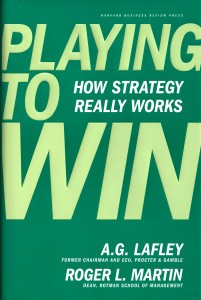The one-sentence summary
Strategy is choice – there is no point in just competing, you need to win.
Can’t be bothered to read it read it? Listen to the 5-minute summary.
WHAT THE BOOK SAYS 
• This is a guidebook of how strategy really works, by the CEO of Procter & Gamble and his collaborator from Toronto’s Rotman School of Management.
• Winning only happens when you make hard choices, and that means leaving behind the status quo.
• Strategy is not complex, but it is hard, because of the pain of these choices.
• The five crucial strategic choices (described as a cascade) are:
1. What is our winning aspiration? This is not the strategy – just a start.
2. Where will we play? Exclusions are helpful – don’t start multiple wars.
3. How will we win in chosen markets? Look at cost and differentiation.
4. What capabilities must be in place to win? Create an activity system.
5. What management systems are required to support the choice?
• Where to play and how to win should be examined on four levels – the strategy logic flow: industry, customers, relative position, and competition.
• They propose Nested Choice Cascades, in which each step is viewed at corporate, strategic group and individual business level. These are then joined by Reinforcing Rods that bind activity systems together strongly.
• Three main themes enable a company to win:
1. Make the consumer the boss.
2. Win the consumer value equation.
3. Win the two most important moments of truth (first customer encounter of product in-store, and first use at home).
WHAT’S GOOD ABOUT IT
• It references Theodore Levitt’s Marketing Myopia, in which companies cannot see beyond the specification of the products they make and so miss their higher purpose (think mobile phones v. connecting people).
• Meetings at P&G were changed in three ways: no presentation (only a discussion of strategic issues agreed in advance), only 4-5 people (down from 20-25), and a maximum of 3 pages of new material in response to queries.
• The new discussion style was assertive inquiry, which blends advocacy (what I think), with inquiry (listen properly), best summarised in the sentence “I have a view worth hearing, but I may be missing something.”
• The most powerful strategic question is: what would have to be true? (in order to proceed). Reverse engineering then leads to better choices.
• VUCA is Volatile, Uncertain, Complex, Ambiguous – the standard business environment now.
• Six common strategy traps are highlighted:
1. Do-it-all: making everything a priority.
2. Don Quixote: taking on the strongest competitors.
3. Waterloo: starting wars on multiple fronts at the same time.
4. Something-for-everyone: going for everyone, everywhere.
5. Dreams-that-never-come-true: high-level aspirations that never happen.
6. Program-of-the-month: generic industry strategies where everyone is chasing the same people in the same way.
WHAT YOU HAVE TO WATCH
• This is very American, with an almost breathless emphasis on the endless pursuit of winning.
• Almost all examples are drawn from P&G, so they need careful application elsewhere.
.
